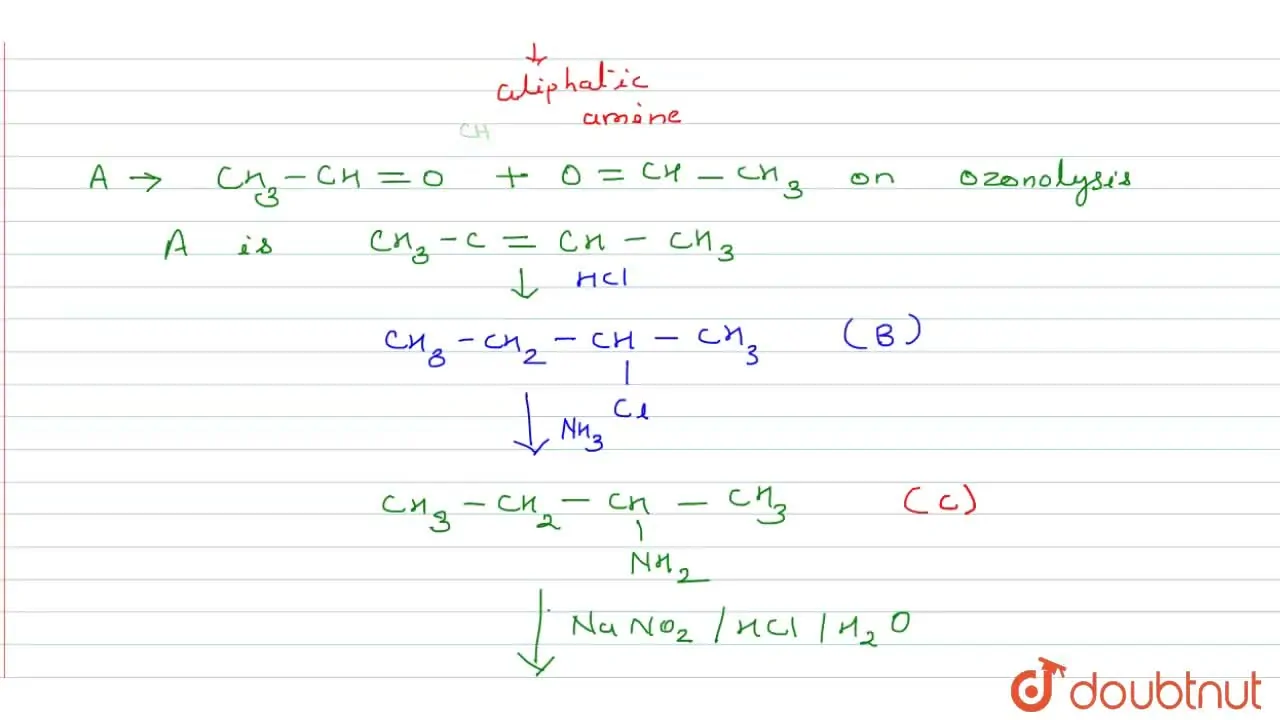A hydrocarbon 'A' (C4H8) on reaction HCl gives a compound 'B', (C4H9Cl) which on reaction with 1 mol of NH3 gives compounds 'C' (C4H11N). On reacting with NaNO2 and HCl followed by treatment with water compound 'C' yields an optically active alcohol, 'D'. Ozonolysis of 'A' given 2mols of acetyldehyde. Identify compound 'A' to 'D'. Explain the reaction involved.
(i) M.F. of compound A (C4H8) corresponds to the general formula CnH2n where n = 4, therefore, A is an alkene.
Since azonolysis of hydrocarbon .A. (C4H8) gives two moles of acetaldehyde, therefore, hydrocarbon .A. must be a symmetrical alkene, i.e., but-2-ene.

(ii) Since but-2-ene reacts with HCl to form compound .B. (C4H9Cl), therefore, .B. must be 2-chlorobutane.
(iii) Since compound (B), i.e., 2-chlorobutane reacts with one mole of NH3 to give compound (C), therefore, compound (C) must be a 1∘ amine, i.e., butan - 2- amine.

(iv) Since compound .C. reacts with NaNO2/HCl(HNO2) to give an alcohol .D.. therefore, compound .D. must be butan - 2- ol.

Related Playlists
Similar Questions
A hydrocarbon 'A' (C4H8) on reaction HCl gives a compound 'B', (C4H9Cl) which on reaction with 1 mol of NH3 gives compounds 'C' (C4H11N). On reacting with NaNO2 and HCl followed by treatment with water compound 'C' yields an optically active alcohol, 'D'. Ozonolysis of 'A' given 2mols of acetyldehyde. Identify compound 'A' to 'D'. Explain the reaction involved.
View SolutionA hydrocarbon 'A' (C4H8) on reaction HCl gives a compound 'B', (C4H9Cl) which on reaction with 1 mol of NH3 gives compounds 'C' (C4H11N). On reacting with NaNO2 and HCl followed by treatment with water compound 'C' yields an optically active alcohol, 'D'. Ozonolysis of 'A' given 2mols of acetyldehyde. Identify compound 'A' to 'D'. Explain the reaction involved.
View SolutionA hydrocarbon 'A' (C4H8) on reaction HCl gives a compound 'B', (C4H9Cl) which on reaction with 1 mol of NH3 gives compounds 'C' (C4H11N). On reacting with NaNO2 and HCl followed by treatment with water compound 'C' yields an optically active alcohol, 'D'. Ozonolysis of 'A' given 2mols of acetyldehyde. Identify compound 'A' to 'D'. Explain the reaction involved.
View SolutionCompound (x)(m.f=C7H8N), on reaction with NaNO2 and conc. HCl at O∘C followed by β− naphthol gives orange coloured dye. Compound (x) is :
View SolutionCompound A (C7H14) decolourises Br2 in CCl4 and reacts with Hg(OAc)2 followed by reduction with NaBH4 to produce a resolvable compound B. A undergoes reductive ozonolysis to give
 as one of the compound.
as one of the compound.
Identify A and B.View SolutionOptically active isomer (A) of (C5H9Cl) on treatment with one mole of H2 gives an optically inactive compound (B) compound (A) will be :
View SolutionOptically active isomer (A) of (C5H9Cl)on treatment with one mole of H2 gives an optically inactive compound (B) compound (A) will be :
View SolutionAn alkene (A)C16H16 on ozonolysis gives only one product (B)(C8H8O). Compound (B) on reaction with NH2OH followed by reaction with H2SO4,Δ gives N - methyl benzamide the compound 'A' is -
View SolutionAn organic compound A(C4H9Cl) on the reaction with Na/diethly ether gives a hydrocarbon which on monochlorination gives only one chloro derivative then, A is
View SolutionTreatment of benzene with CO/HCl in the presence of anhydrous AlCl3/CuCl followed by reaction with Ac2O/NaOAc gives a compound X. Reaction of X with H2/Pd/c followed by treatment with H3PO4 gives another compound Y. The compound Y is :
View Solution


